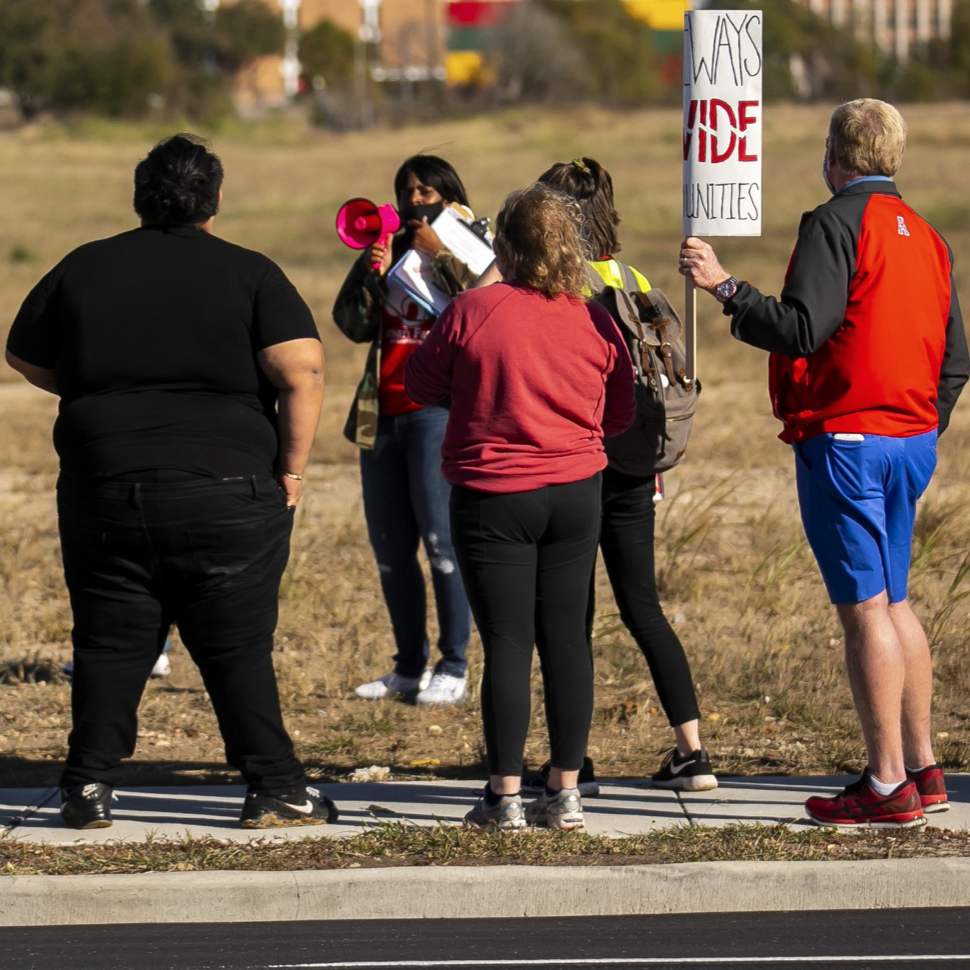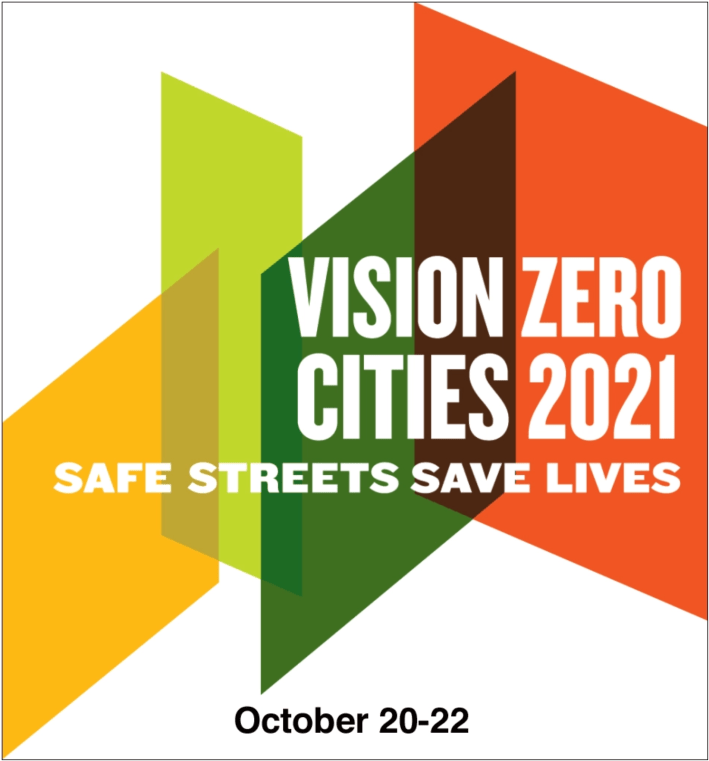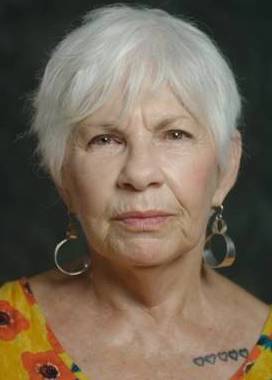Editor’s Note: A version of this article will appear in Transportation Alternatives’s Vision Zero Cities Journal as part of the 2021 Vision Zero Cities Conference, Oct. 20-22, including walking and biking tours on Oct. 22. You can register for the virtual conference (and for New York City residents, in-person tours) at visionzerocities.org.
In 2002, the Texas Department of Transportation proposed alleviating congestion in the Houston region by expanding a massive freeway. Despite almost two decades of problems, rising traffic fatalities, the astounding proposed cost of $7 billion, the time-tested assurance that new lanes will quickly fill with new traffic, substantial community opposition, a lawsuit from the county itself, and the project’s estimated displacement of 1079 homes, 344 businesses, five places of worship, and two schools, planning for the project continues.
We are here to stop it.
The fight to halt the TxDOT expansion of Interstate 45 pre-dates the birth of our organization, Stop TxDOT I-45. It began with the Make I-45 Better Coalition, an established, grasstops-style coalition formed in response to the Draft Environmental Impact Statement in 2015 and spearheaded by clean-energy entrepreneur Michael Skelly. Groups from across Houston — from research institutes to the Parks Board — signed a letter penned by transportation and environmental engineers and lawyers, asking TxDOT to open a conversation about improving the design. TxDOT would not listen. Despite the lack of early success, the coalition proved the potential of such disparate groups uniting around the effort to halt a senseless and wasteful interstate expansion.
I have lived in Near Northside, a predominantly Latinx and middle-income neighborhood just north of downtown Houston, for seven years, and my involvement with a local neighborhood organization first brought the I-45 project to my attention. In 2019, TxDOT officials began presenting their plans at community meetings and casually discussing how I-45 would affect our neighborhoods. Because of TxDOT’s abysmal track record of community engagement, destroying black and brown neighborhoods with highways, and the epidemic of traffic fatalities in Houston, I did not trust TxDOT to “make it better.” I wanted the project, which would widen the already-massive I-45 freeway to 34 lanes at one point, to be stopped entirely. A neighbor and I began to crowdfund, made yard signs, and picketed the next community engagement meeting.
New to advocacy, we also attended a technical training offered by LINK Houston, a transportation-advocacy nonprofit, through Avenue CDC, an affordable housing nonprofit. They provided support on how to engage and advocate to change TxDOT-sized infrastructure projects. Air Alliance Houston , an air quality advocacy nonprofit, published a Health Impact Study of the expanded freeway’s effect on schools along the corridor, finding negative health effects in local schoolchildren, and then pushed that data out through events, newsletters and social media. With the help of these organizations, Stop TxDOT I-45 was born, and together we organized over 60 speakers at a regular meeting of the Metropolitan Planning Organization, the decision-makers in charge of approving funding for the expansion. That day, the Transportation Policy Council — which has disproportionate representation from outlying counties, where many residents commute into Houston on the freeway — voted in favor of the expansion. But for the first time, it seemed that community organizing could rival the power of a multibillion-dollar DOT project.
Since then, Stop TxDOT I-45 has grown into a thriving organization. We are grassroots: no budget, no staff. We are experts and lay-people, advocates and community members, and we belong to different political parties. We have a few dedicated facilitators, but we celebrate leadership in everyone. We try to keep realistic expectations for anyone who does the work. We are all volunteers with jobs, families, health problems, and more. One of our ground rules is to relinquish a task as soon as you realize you have over-committed yourself without shame or guilt. We found that people work hard, sometimes disappear, and often reappear later. It works for us. Because of this horizontal structure, we have employed a wide variety of actions throughout the last two years, and we have learned a lot.
After successfully turning out so many speakers at the MPO’s meeting, Stop TxDOT got to work making I-45 a hot-button issue in our local election cycle. We relentlessly showed up at candidate events with our signs, a tactic called bird-dogging. It worked: any candidate whose district overlapped with I-45 was forced to pick a side. Meanwhile, we built relationships with like-minded elected officials, partnerships that became crucial as the movement grew. We would not be where we are today without key elected officials who championed this cause. Our city, feeling public pressure, created its own community engagement process, which produced more palatable alternative designs. The county filed a lawsuit. We are thankful for their critical participation.

We decided to incorporate direct action into our strategy. We showed up outside of meetings of adversarial organizations carrying signs and chanting. We held a few small but mighty non-violent direct actions that helped capture the attention of the media. We created a 6-foot-tall banner that demanded “NO I-45 EXPANSION” and hung it over the freeway. Our giant banner became an icon of our people-power. We invaded a contentious intersection that will be disrupted by the expansion. We held a community walk, a tour through historic sections of town that stand to be destroyed, highlighting all that we could lose.
When COVID-19 hit, we took our organizing completely online. Over the summer of 2020, we put on masks, headed back outside, and knocked on every impacted door we could reach to build relationships, learn from the people most impacted, and share any information we had. We have found that nothing can replace knocking on doors and having face-to-face conversations with our neighbors. At the end of 2020, the Final Environmental Impact Statement dropped. Originally, TxDOT only allotted a 30-day comment period for an eight-and-a-half thousand page document. We leveraged every political relationship we had to request more time, and won an additional 30 days: just enough. We got busy reading and showing up to community engagement meetings, learning how to respond in the official comment period and continuing to recruit. We developed our own organization’s official response and comments with the help of our partner organizations. We hosted a “Day at the Park,” where we invited community members, advocates, and elected officials to gather at a local bayou greenway which stands to be utterly destroyed by the expansion. At the event, we had a station where attendees could learn how to write and submit their own technical comments to the FEIS. We hosted a series of outdoor community concerts where we also trained people how to comment.
Because Texas is the only state with no dedicated transit funding, we advocated for bills at the 2021 Texas Legislative session. Using donations, we took 15 people from Houston to Austin in two vans, none of whom had ever testified previously. When it became obvious that the state was not going to make TxDOT change, we knew we had to find a way to go over their heads. We helped residents and organizations submit civil rights complaints to the federal government, which has to sign off on TxDOT’s process. Now the project is paused while the Federal Highway Administration investigates these complaints.
An outdoor community concert, where the audience could learn how to submit technical comments to the FEIS. Photo: Stop TxDOT I-45
Throughout the last two years, we have showed up and commented at every single meeting of our MPO, and countless meetings of the City, County, Texas Transportation Commission and other adjacent bodies. We watch the process closely and publish a newsletter, now in English and Spanish, whenever there is news. We host biweekly general meetings on Zoom that are open to anyone and sporadically host virtual “office hours” where anyone can come and go to learn and meet one another. Our social media accounts regularly feature history, action items, and civic engagement tips. We try to make it easy to show up for every event, meeting, and action.
Now we are knocking on doors again to let people know that the FHA is coming to town as part of their Title VI investigation process. We are coordinating responses to yet another survey with other organizations fighting the same fight in El Paso and Austin. And we are planning our second birthday party. We celebrate constantly, and fun is one of our values. Everyone is welcome at the table. Every successfully-completed action, whether it meets its stated goals or not, is a win in our book. (And celebrated!)
The devastation of urban freeways is infamous in Houston: people displaced, sickened, killed and injured, and communities destroyed. The ongoing fight to stop TxDOT from widening I-45 is years-long, and mired in confusing and technical details designed to discourage public participation. The stranglehold of single-occupancy vehicles on our city is upheld by powerful financial interests, the misrepresentation of our history, and a culture of apathy. Yet, despite these formidable hurdles, the I-45 expansion is paused with a lawsuit filed. If we can stop a freeway in Houston, if we can awaken imaginations to alternatives, you can too.
Susan Graham, a retired nurse and resident of the Near Northside in Houston, Tex., founded Stop TxDOT I-45, a grassroots organization fighting for equitable, sustainable, strategic transportation policy in Texas.









